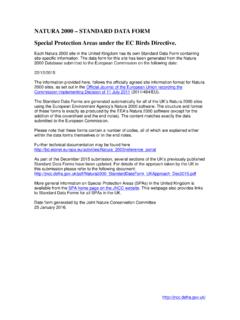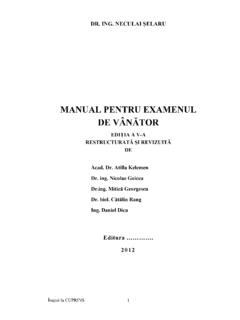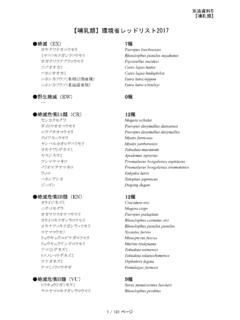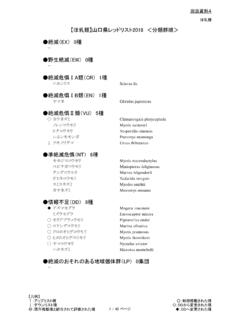Transcription of Life histories of birds: clutch size, longevity, and …
1 2739 Life histories of birds: clutch size, longevity, and body mass amongNorth American game birdsRICHARD M. ZAMMUTOK ananaskis Centre for Environmental Research, University of Calgary, Seebe, Alta., Canada TOL lXOReceived December 11, 1985 ZAMMUTO, R. M. 1986. Life histories of birds: clutch size, longevity, and body mass among North American game birds. Can. 64: size, longevity, and body mass data for 54 North American game birds were extracted from the literature to test thehypothesis that a trade-off exists between fecundity and survival among avian species. Species with larger clutch sizes liveshorter lives than species with smaller clutch sizes (r = - , n = 54, P < ). This relationship still holds when the effects," of body mass are removed (r = ,51 df, P < ), indicating that the relationship is not simply a function of body latter finding is inconsistent with previous life-history studies, perhaps because previous researchers did not attempt toremove body mass effects from their life-history investigations.
2 Results are similar (P < ) when mean values of life-historytraits are examined at the generic level. However, no relationships (P > ) among mean values of life-history traits occur at'"' any taxonomic level higher than genus or when species are grouped with respect to feeding habits. This might be the result of lowsample size. I conclude that the evolution of clutch size is influenced by longevity, or vice versa, among species and genera ofNorth American game , R. M. 1986. Life histories of birds: clutch size, longevity, and body mass among North American game birds. Can. 64: donnees sur 54 especes nord-americaines de gibier a plume ont ete reperees dans la litterature (nombre d' oeufs par couvee,longevite et masse totale) afin de verifier I 'hypothese selon laquelle il s' etablit un equilibre entre al fecondite et la survie chez lesoiseux.
3 Les especes qui pondent plus de petits ont une duree de vie plus courte que les especes qui pondent moins d'oeufs(r = -0,38, n = 54, P < 0,01). Cette affirmation reste vraie lorsque les effets de lamasse totale sontelimines (r = -0,34,51 dl,P < 0,05), ce qui demontre que cette relation n'est pas seulement une fonction de la masse totale. Cette conclusion vient aI' encontre des etudes anterieures sur Ie developpement, peut-~tre parce que les chercheurs n' ont pas elimine les effets de la massedu corps au cours de leurs investigations. Les resultats sont semblables (P < 0,05) lorsque les valeurs moyennes des parametresdu developpement sont examines au niveau generique. Cependant, il n'y a pas de relation (P > 0,05) entre les valeurs moyennesde ces parametres a des niveaux taxonomiques superieurs au niveau generique ou lorsque les especes sont regroupees en fonctionde leurs habitudes alimentaires.
4 II faut peut-~tre reconnaitre la l'effet de la taille trop faible de l'echantillon. Je conclus quel'evolution du nombre d'oeufs par couvee est influencee par la longevite, ou vice versa, chez les especes ou les genresnord-americains de gibier a plume.[Traduit par la revue]Introduction traits (Western and Ssemakula 1982; Peters 1983; Calder 1984;Theoretical arguments suggest that costs of reproduction, Lindste~t et al. 1986). However, rec7nt e~idence from partialsuch as the amount of energy used, predation risks, exposure to correl~nons sugges!s that the relationship between ag~ ~t Ielements, and accidents (see Ricklefs 1974), should adversely matunty and may not depend upon body mass withinaffect survival rates in animals (Cody 1966' Williams 1966' and among species of mammals (Harvey and Zammuto 1985).Chamov and Krebs 1974' Steams 1976' B~ll 1980 1984a' This raises the possibility that relationships observed among.)
5 1984b). For example, clutch size is a m;jor cost in r~produc: li!e-history traits of birds do not depend solely upon body masstion, so it should inversely covary with longevity in birds erther..(Haukioja and Hakala 1979; Stenseth 1984; Reznick 1985).. My purpose ,-:,as to examine re!anonship between clutch ~ However, empirical studies of birds have not always provided Size and longevity, and rt~ depend~ncy upon bodyconvincing evidence of this relationship. Some instraspecific ~ass among North Am~ncan g~me bIrds. An. inverse correla-studies have supported the expected inverse relationship be- non (P < ) between clutch and l .ngevity, corr~cted fortween reproduction and survival (Goodman 1974' Askenmo body mass effects, would be consistent With the fecundrty-sur-1979; Bryant 1979; Nur 1984; Ekman and Aske~mo 1986), vivaltr~de-offhypothesisandthebalancedmo rtalityhypothesiswhereas others have indicated either a positive or no relation- (~ee 1974; ~ell 1984a).
6 These hyp~theses propose t~atship between these traits (De Steven 1980; Hogstedt 1981; either hIgh. ac~ompames low survIval or low fe~undrtySmith 1981; Roskaft 1985). Interspecific studies of mammals high survIval ?eca~se c,osts of reprod~cnon arehave supported the predicted inverse relationship between litter mamfested as r~du~ed survIval mammals. Game bIrds weresize and survival (Tuomi 1980; Millar and Zammuto 1983), chosenf, ~auselarge~ccuratesamplesofmeanwhereas interspecific studies of birds on the subject are lacking. clut~h SIzes and 10ngevInes are avaIlable. few data areLife-history studies of birds and mammals indicate that lon- a~aIlablefor a comparable study on nongame b~rds.(se~ samplegevity, clutch size, and litter size correlate highly with body mass Sizes of Clapp et al. 1982, ,clapp et al. 1983; KIImkIewIcz et al.)
7 (Sacher 1959; Lindstedt and Calder 1976, 1981; Blueweiss-et al. 1983; compare changes with Kennard 1975).1978; Western 1979; Tuomi 1980; Cabana et al. 1982; Westernand Ssemakula 1982; Millar and Zammuto 1983; Calder 1984). MethodsBody mass has been proposed to be the underlying variable clutch size as completed clutches, longevity derived from bandingcausing the relationships observed among many life-history records or life tables, and body mass of adult females were extracted2740 CAN. J. ZOOL. YOLo 64. 1986 TABLE 1. clutch size, longevity, body mass, and ecological ~ategories for 36 North American waterfowlMean Femaleclutch Longevityb body Ecologicalsize (n)a (years) massc (g) categoryd ReferenceseFulvous Whistling-Duck(Dendrocygna bicolor) (17) 710 I 1,2 Black-bellied Whistling-Duck(Dendrocygna autumnalis) (778) 8.
8 2 849 1 3 Greater White-fronted Goose(Anser albifrons) (378) 2587 1 2,4,5 Snow Goose(Chencaerulescens) (1196) 25401 1 6-8 Ross' Goose (Chen rossii) (906) 1588 1 9 Emperor Goose .(Chen canagica) (791) 2750 1 4,10 Brant (Branta bernicla) (2860) 1230 1 2,4,11 Canada Goose .(Brantacanadensis) (17295)g 30331 1 4,8,12-29 Wood Duck (Au sponsa) (2844) 635 2 2,8,29-36 Green-winged Teal(Anascrecca) (126) 318 2 2,8,37,38 American Black Duck(Anas rubripes) (1182) 1100 2 2,8,29,39,40 Mottled Duck(Anasfulvigula) (1467) 968 2 2,29,41,42 Mallard (Anas platyrhynchos) (1725) 1082 2 29,37,38,40,43-51 Northern Pintail(Anas acuta) (1668) 986 2 2,8,37,38,44,45,49,52 Blue-winged Teal(Anasdiscors) (3197) 363 2 8,29,37,38,47,52-59 Cinnamon Teal(Anas cyanoptera) (1928) 363 2 2,29,44,45,47,49,60 Northern Shoveler(Anas clypeata) (861) 590 2 2,8,37,38,44,45,47,49 Gadwall (Anas strepera) (4168) 849 2 2,8,37,38,42,44,45,49,53,85 American Wigeon(Anas americana) (144) 719 2 2,8,37,38,47 Canvasback(Aythya valisineria) (2193) 1190 3 2,37,58,61-63 Redhead(Aythya americana)
9 (1772) 990 3 2,8,37,45,49,62,64,65 Ring-necked Duck(Aythya collaris) (487) 680 3 8,29,58,66 Greater Scaup(Aythya marila) (1551) 957 3 2,42,67 .Lesser Scaup(Aythya affinis) (896) 790 3 2,8,37,45,58 Common Eider.(Somateria mollissima) (9327) 1915 3 68- 74 King Eider(Somateria spectabilis) (53) 1567 3 2,75 Steller's Eider(Polysticta stelleri) (10) 842 3 2,76,77 Oldsquaw(Clangulahyemalis) (307) 814 3 2,29,42,78 White-winged Scoter(Melanittafusca) (355) 1200 3 2,29,79,80,87 Common Goldeneye(Bucephala clangula) (148) 800 3 2,8,81,86 Barrow's Goldeneye(Bucephala islandica) (333) 730 3 2,42 Bufflehead(Bucephala albeola) (263) 334 3 82 Hooded Merganser(Lophodytes cucullatus) (218) 540 3 2,8,83 ZAMMUTO 2741 TABLE 1. (concluded)rMean Femaleclutch Longevityb body Ecologicalsize (n)a (years) massc (g) categoryd ReferenceseCommon Merganser(Mergus merganser) (87) 1232 3 8,29,79 Red-breasted Merganser(Mergus serrator) (342) 908 3 2,8,29,42,67,79 Ruddy Duck(Oxyurajamaicensis) (401) 499 3 2,8,37,44,45,49,64,65,84"Weighted mean from listed references after adjustment for repeated data of review publications where possible.
10 Sample size in from banding records (Clapp et al. 1982; Clapp et aI. 1983; Houston and Brown 1983).. 'All body mass data were extracted from Dunning (1984). Some "female" masses are for both sexes combined where sexual dimorphism does not exist or study didnot category determined by feeding habits outlined in Martin et al. (1951): I, geese; 2, puddle ducks; 3, diving ducks.'References: I, Cottam and Glazener 1959; 2, Bellrose 1976; 3, McCamant and Bolen 1979; 4, Mickelson 1975; 5, Lensink 1969; 6, Lemieux 1959; 7, Uspenskii" 1965; 8, Peck and James 1983; 9, Ryder 1967; 10, Eisenhauer and Kirkpatrick 1977; II, Barry 1962; 12, Steel et al. 1957; 13, Kossack 1950; 14, Williams andMarshall 1937; 15, Naylor 1953; 16, Miller and Collins 1953; 17, Naylor and Hunt 1954; 18, Geis 1956; 19, MacInnes etal. 1974; 20, Vermeer 1970; 21, Hanson andEberhardt 1971; 22, Dow 1943; 23, Dimmick 1968; 24.





